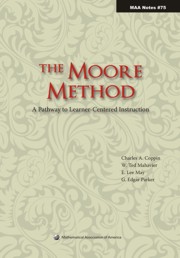Book contents
- Frontmatter
- Contents
- Dedication
- Acknowledgements
- 1 Introduction
- 2 Moore's Moore Method
- 3 What is the Moore Method?
- 4 On Culture
- 5 Development and Selection of Materials
- 6 In the Classroom
- 7 Grading
- 8 Why Use the Moore Method?
- 9 Evaluation and Assessment: Effectiveness of the Method
- 10 Frequently Asked Questions
- Appendices
- I Coppin
- II Mahavier
- III May
- IV Parker
- About the Authors
- References
- Index
I - Coppin
from Appendices
- Frontmatter
- Contents
- Dedication
- Acknowledgements
- 1 Introduction
- 2 Moore's Moore Method
- 3 What is the Moore Method?
- 4 On Culture
- 5 Development and Selection of Materials
- 6 In the Classroom
- 7 Grading
- 8 Why Use the Moore Method?
- 9 Evaluation and Assessment: Effectiveness of the Method
- 10 Frequently Asked Questions
- Appendices
- I Coppin
- II Mahavier
- III May
- IV Parker
- About the Authors
- References
- Index
Summary
I.A Syllabus for Linear Point Set Theory
Math 3321
Fall, 2011
SYLLABUS
Instructor: Charles Coppin
Office: SB 50 (lower level)
Office Hours: 2:00–3:00 MW; 2:00–3:30 F or by appointment
Text: Notes
Content: An axiomatic development of the numbers. A study of limit points, convergent sequences, compact sets, connected sets, dense sets, nowhere dense sets, separable sets
Objectives and Issues: The primary objective of Math 3321 is to begin to inculcate in you those mental processes that characterize mathematical thought. This course will develop your powers of deduction and imagination. You will learn to use language precisely and concisely. Settling conjectures, creating counterexamples and conceptualizing an abstract definition will stretch your imagination.
I have taught this course twenty-seven years at the University of Dallas. We will attempt to run this course in the spirit of R. L. Moore, the father of the American school of point set topology. In his prime, he was considered to be one of the top ten mathematicians in the world. He was considered to be one of the most effective teachers in collegiate mathematics in the first half of this century.
The format is not lecture. There are no surprises about the way people learn. Vince Lombardi, the coach of the Green Bay Packers in their heyday, said that football is nothing more than blocking, tackling, and running—the fundamentals. We will also stress the fundamentals of mathematics—logic and imagination.
Information
- Type
- Chapter
- Information
- The Moore MethodA Pathway to Learner-Centered Instruction, pp. 177 - 200Publisher: Mathematical Association of AmericaPrint publication year: 2009
